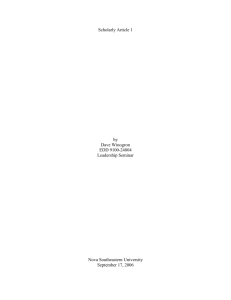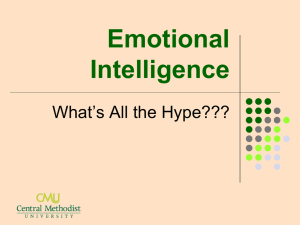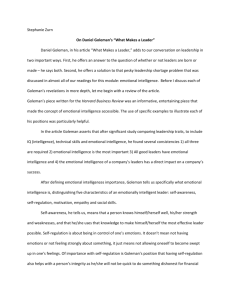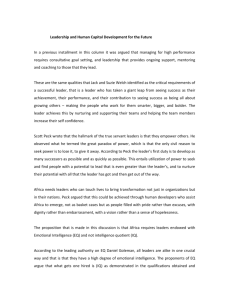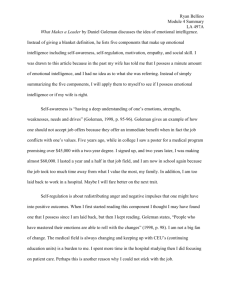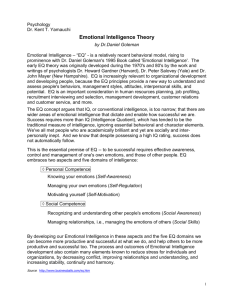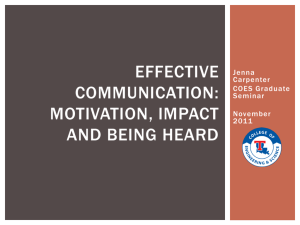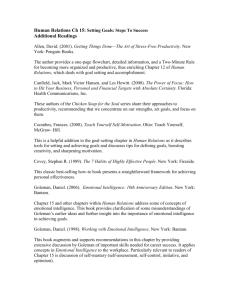Emotional Intelligence: What Works at Work
advertisement
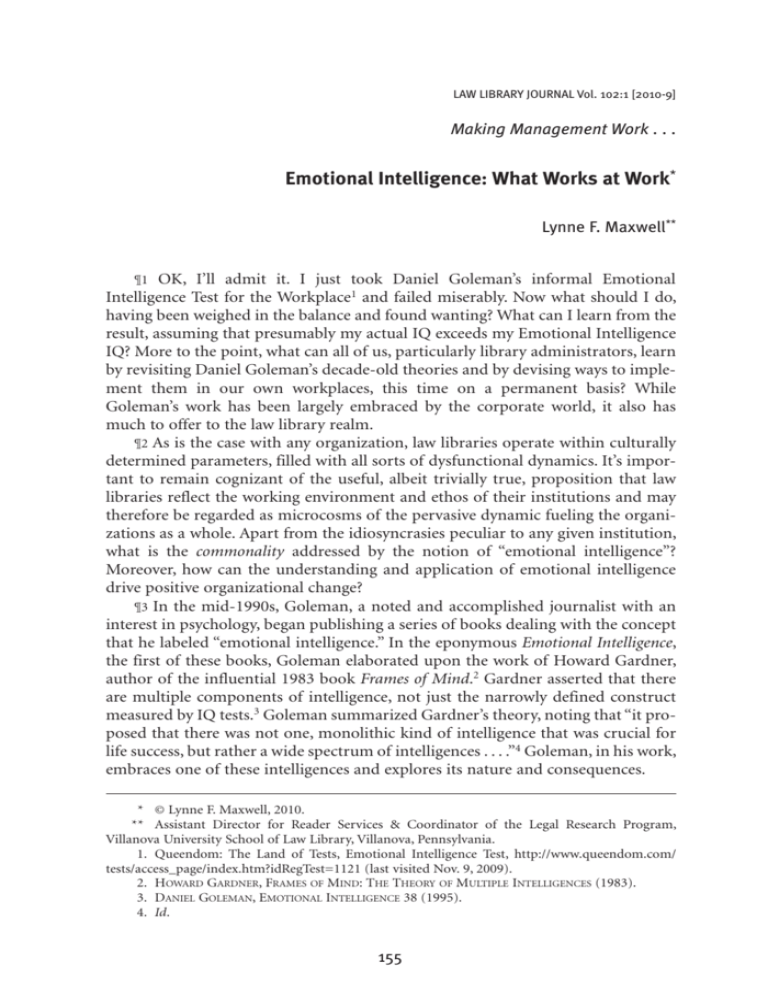
LAW LIBRARY JOURNAL Vol. 102:1 [2010-9] Making Management Work . . . Emotional Intelligence: What Works at Work* Lynne F. Maxwell** OK, I’ll admit it. I just took Daniel Goleman’s informal Emotional Intelligence Test for the Workplace1 and failed miserably. Now what should I do, having been weighed in the balance and found wanting? What can I learn from the result, assuming that presumably my actual IQ exceeds my Emotional Intelligence IQ? More to the point, what can all of us, particularly library administrators, learn by revisiting Daniel Goleman’s decade-old theories and by devising ways to implement them in our own workplaces, this time on a permanent basis? While Goleman’s work has been largely embraced by the corporate world, it also has much to offer to the law library realm. ¶2 As is the case with any organization, law libraries operate within culturally determined parameters, filled with all sorts of dysfunctional dynamics. It’s important to remain cognizant of the useful, albeit trivially true, proposition that law libraries reflect the working environment and ethos of their institutions and may therefore be regarded as microcosms of the pervasive dynamic fueling the organizations as a whole. Apart from the idiosyncrasies peculiar to any given institution, what is the commonality addressed by the notion of “emotional intelligence”? Moreover, how can the understanding and application of emotional intelligence drive positive organizational change? ¶3 In the mid-1990s, Goleman, a noted and accomplished journalist with an interest in psychology, began publishing a series of books dealing with the concept that he labeled “emotional intelligence.” In the eponymous Emotional Intelligence, the first of these books, Goleman elaborated upon the work of Howard Gardner, author of the influential 1983 book Frames of Mind.2 Gardner asserted that there are multiple components of intelligence, not just the narrowly defined construct measured by IQ tests.3 Goleman summarized Gardner’s theory, noting that “it proposed that there was not one, monolithic kind of intelligence that was crucial for life success, but rather a wide spectrum of intelligences . . . .”4 Goleman, in his work, embraces one of these intelligences and explores its nature and consequences. ¶1 * © Lynne F. Maxwell, 2010. ** Assistant Director for Reader Services & Coordinator of the Legal Research Program, Villanova University School of Law Library, Villanova, Pennsylvania. 1. Queendom: The Land of Tests, Emotional Intelligence Test, http://www.queendom.com/ tests/access_page/index.htm?idRegTest=1121 (last visited Nov. 9, 2009). 2. Howard Gardner, Frames of Mind: The Theory of Multiple Intelligences (1983). 3. Daniel Goleman, Emotional Intelligence 38 (1995). 4. Id. 155 156 Law Library Journal Vol. 102:1 [2010-9] ¶4 Succinctly defined, “[e]motional intelligence . . . refers to the abilities to recognize and regulate emotions in ourselves and in others.”5 Goleman subdivided this into four categories: self-awareness, self-management, social awareness, and relationship management.6 ¶5 Goleman then began thinking about the larger implications of emotional intelligence and its extended applications. In Emotional Intelligence, he initially recognized that emotional intelligence could be applied to the workplace setting, but “Managing with Heart,” is the lone chapter dealing with organizational applications of his theory. Goleman begins by noting that in the workplace motivation is crucial and that criticism without possibility of feedback can be severely counterproductive, possibly “the worst way to motivate someone.”7 While this is no real revelation, it does prompt Goleman to further consider “this destructive dynamic”:8 The emotional vicissitudes at work in marriage also operate in the workplace, where they take similar forms. Criticisms are voiced as personal attacks rather than complaints that can be acted upon; there are ad hominem charges with dollops of disgust, sarcasm and contempt; both give rise to defensiveness and dodging of responsibility and, finally, to stonewalling or the embittered passive resistance that comes from feeling unfairly treated. . . . It leaves the person receiving it feeling helpless and angry. From the vantage point of emotional intelligence, such criticism displays an ignorance of the feelings it will trigger in those who receive it, and the devastating effect those feelings will have on their motivation, energy, and confidence in doing their work.9 Later in the chapter, Goleman expands his discussion of the “destructive dynamic” by going beyond the individual repercussions of emotional stupidity (my term) and encompassing its deleterious effects at a larger organizational level. In a section entitled “Organizational Savvy and the Group IQ,” Goleman cites to management guru Peter Drucker, who articulated the (again hardly novel) concept that the whole is larger than the sum of its parts. Goleman endorses Drucker’s evaluation of work trends, particularly with regard to “knowledge workers” like ourselves, for whom “‘teams become the work unit rather than the individual himself.”’10 ¶6 In order for teams to reach optimal productivity—or, indeed, to be productive at all––their individual members must bring both traditional intelligence and emotional intelligence to the group.11 “The key to a high group IQ,” Goleman asserts, “is social harmony.”12 When such social harmony exists, informal networks complement formal ones, allowing for more flexibility and innovation in problem solving. According to Goleman, informal networks are especially critical for handling unanticipated problems. As one would expect, harmonious relationships 5. Daniel Goleman, Emotional Intelligence: Issues in Paradigm Building in The Emotionally Intelligent Workplace 13, 14 (Cary Cherniss & Daniel Goleman eds., 2001). 6. Id. 7. Goleman, supra note 3, at 153. 8. Id. at 151. 9. Id. 10. Id. at 159 (quoting Peter Drucker, The Age of Social Transformation, Atlantic Monthly, Nov. 1994, at 53, 68). 11. See id. at 160. 12. Id. Vol. 102:1 [2010-9] emotional intelligence: what works at work encourage individuals to collaborate with the team in order to generate mutually beneficial ideas and solutions.13 Absent high emotional intelligence, teams will lack requisite cohesiveness, and, in fact, will not function as teams at all. Dysfunctionality begets more dysfunctionality, creating a downward spiral that cannot be rectified without conscious, emotionally intelligent intervention. ¶7 Given the notion of emotional intelligence, Goleman’s evolving theoretical construct, how can library administrators capitalize upon his research and wisdom? Well, emotional intelligence or competence begins at home, as can be seen in Goleman’s “Emotional Competence Framework,” as articulated by Marilyn Gowing.14 Library managers must study and develop the emotional competencies before being able to effectively implement and model them. Of course, that is intuitively obvious, but how to accomplish this is a difficult lifelong project for both individuals and organizations. ¶8 The Framework includes a number of factors necessary for evaluating emotional competence. The categories under which these fall are: personal competence (“How we manage ourselves”) and social competence (“How we handle relationships”). Within each category there are various, more specific, sub-categories. Thus, to measure personal competence, self-awareness, self-regulation, and motivation must be examined. To measure social competence, empathy and social skills are the qualities warranting scrutiny.15 Again, all of this might seem a bit simplistic, but developing the ability to practice these traits is a gargantuan task. ¶9 First, personal competence requires self-awareness, which entails emotional awareness (“[r]ecognizing one’s emotions and their effects”), accurate self-assessment (“[k]nowing one’s strengths and limits”), and self-confidence.16 Moreover, it requires self-regulation, which in turn entails self-control, trustworthiness, conscientiousness, adaptability, and innovation. It further requires motivation, the drive to achieve, commitment, initiative, and optimism.17 ¶10 While personal competence reflects individual traits, social competence emphasizes the way in which an individual is aware of others. Empathy entails understanding others, developing others (i.e., sensing others’ development needs and bolstering their abilities), “service orientation,” “leveraging diversity,” and “political awareness.”18 Social skills emanate from empathic skills. For Goleman, social skills consist of the following abilities: influence, communication, conflict management, leadership, catalyzing change, building bonds, collaboration and cooperation, and team capabilities.19 ¶11 On the most reductive level, library administrators or managers should seek to cultivate self-awareness. If they do not know their emotions or recognize the potential effects of these emotions, problems may arise when emotions sabotage 13. See id. at 162. 14. Marilyn K. Gowing, Measurement of Individual Emotional Competence, in The Emotionally Intelligent Workplace, supra note 5, at 83, 88–89. 15. Id. 16. Id. at 88. 17. Id. 18. Id. at 89. 19. Id. 157 158 Law Library Journal Vol. 102:1 [2010-9] perceptions and actions. Recognizing the propensity toward anger, for instance, enables a manager to contain it—or at least allows for that possibility. Knowing trigger points can be helpful in containing or channeling destructive emotions. In addition, library managers can benefit by developing an accurate sense of their own effectiveness. Lacking self-knowledge, managers can delude themselves regarding their actual skill sets and competencies. This, in turn, can lead to personal resentment, disappointment, and frustration spawned by unrealistic assessments of capabilities. Moreover, library managers need to have and convey self-confidence, which is predicated upon accurate self-awareness and assessment. A library leader without self-conviction will fail to inspire confidence in others within the department, thereby complicating or undermining productivity. ¶12 Another component of self-management is self-regulation. Once we become accurately aware of our selves and emotions, we can better check ourselves when inclined to respond impulsively. For instance, recognizing that you tend to write inflammatory e-mails when provoked can enable you to guard against such impulsivity and to therefore prevent unproductive distribution of ill-considered e-mail messages. Consistent trustworthiness and conscientiousness are also traits that should be upheld and modeled by library managers (and everyone else, too, for that matter). Along with these traits, which should have been internalized and should be modeled, self-regulation suggests the ability to remain open to new ideas and change and to be receptive to innovation at all levels. Library managers should remind themselves that change is inevitable and should be welcomed. If managers are sufficiently self-confident and invested in the library, they will embrace change, rather than be threatened by it. ¶13 Self-awareness and self-regulation are prerequisites for motivating librarians and library staff. Motivation requires establishing standards of, and expectations for, achieving excellence. Optimism is necessary for successful motivation. It can be infectious and should emanate from the leading administrators. Effective library leaders are able to immerse themselves in library projects and goals, thereby demonstrating the enthusiasm and commitment that will inspire members of the team. ¶14 Goleman makes much of the category of social competence, as well he should, given that managers’ interactions with others are absolutely critical for establishing a healthy, productive work environment. Empathy is at the heart of social competence. A successful library manager must be aware—or at least attempt to be aware—of others’ feelings and thoughts. If managers lack such empathy, they will fail to provide a nurturing culture—one that encourages personal and professional development. This, in turn, will curb trust, motivation, and job investment. Sensitivity and empathy are traits well worth cultivating in the library environment, where a strong service orientation is crucial. ¶15 Social skills, of course, are essential for achieving social competence. Communication is also key, as is conflict management, since conflicts invariably arise and will fester if not addressed by library administration. Working with others by building bonds for collaboration and cooperation will help any department work more effectively, and managers should do all they can to foster a team envi- Vol. 102:1 [2010-9] emotional intelligence: what works at work ronment. After all, as Goleman has repeatedly emphasized, teamwork is indispensable for achieving essential goals. ¶16 While the focus of this article has largely been on generic management styles within generic organizations, the beauty of Goleman’s theory of emotional intelligence is that, when incorporated by leaders, it can create real positive change for individuals, for teams, for departments, and for entire organizations. Smart library administrators would do well to actively incorporate the tenets of emotional intelligence in their daily practice. And how about me? Well, perhaps I still haven’t succeeded in substantially increasing my emotional intelligence IQ, but at least I can now identify what I should be learning. And isn’t that emotional intelligence, after all? 159
